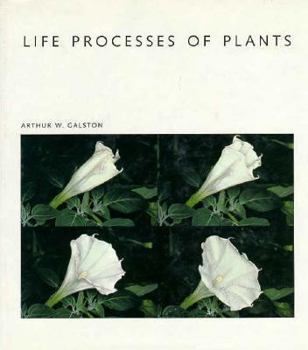Life Processes of Plants
(Book #49 in the Scientific American Library Series Series)
Select Format
Select Condition 
Book Overview
In this volume, botanist Arthur Galston reveals the inner mechanisms that help plants react and change when necessary, including: the internal clock that tells plants the time of day, the chemical... This description may be from another edition of this product.
Format:Hardcover
Language:English
ISBN:0716750449
ISBN13:9780716750444
Release Date:January 1994
Publisher:Scientific American Library
Length:245 Pages
Weight:2.00 lbs.
Dimensions:0.8" x 8.8" x 9.6"
Customer Reviews
1 rating
Excellent
Published by Thriftbooks.com User , 22 years ago
The reader will find in this book an excellent overview of the biophysical and metabolic processes that occur in plants, and, refreshingly, the author seems very much involved in his writing. He is clearly fascinated by the biology of plants, and this enthusiasm comes out in the book. The reader is exposed to a lot in this book, and takes away an appreciation of just what plants are capable of from a physical and biochemical standpoint. In addition, the author does not hesitate to interject discussions of the genetic engineering of plants in the book, making its reading even more interesting. It is written for the "popular audience", but anyone with an interest in plants, students or amateur horticulturists, should enjoy the book. Some of the more interesting discussions in the book include: 1. The rising of the carbon dioxide content of the Earth's atmosphere, particularly since the beginning of the industrial revolution, and the need therefore to retain as much as possible the forests on the planet. 2. The 2/5 phyllotaxic leaf arrangement of the tobacco plant, the goal of which is to optimize the amount of light falling on the leaves. The author throughout the book emphasizes the clever evolutionary strategies of plants. 3. The Priestley experiment showing the opposite effects of animals and plants on enclosed atmospheres. 4. The use of electron-spin-resonance spectroscopy to decipher the sequence of events in photosynthesis. 5. The efficiency of photosynthesis in the creation of a molecule of oxygen: eight photons to release one oxygen molecule, a doubling of the number needed from the theoretical value. 6. The ability of chloroplasts to change their orientation to obtain maximum exposure to light. 7. The overwintering strategies of plants. 8. The ability of the cocklebur to flower if the photoperiod is less than 15.5 hours per day, but not if it exceeds that value by more than a few minutes. 9. The absorption spectra of phytochrome. 10. The measurement of the circadian rhythms. 11. The use of transgenic plants to study the control mechanisms of phytochrome. 12. Growth hormones in plants, particularly the discussion of gibberellins. 13. The phototropism of plants. 14. The mechanism by which plants form chemical toxins in response to injury. 15. The production of ethylene after damage to the plant, activating cell division. 16. The reaction of plants to excessive salinity of the soil. This discussion is very important in the context of recent attempts to develop salt-resistant tomatoes. 17. The ability of a single protoplast to produce an entire plant. 18. Recombinant DNA technology and the production of transgenic plants. This discussion is by far the most fascinating in the book. The recent developments in the genetic engineering of plants has to rank as the most interesting in all of scientific endeavor. 19. The ethical considerations involved in modern biotechnology. In the last sentence of the book the author states that "Plant science h





